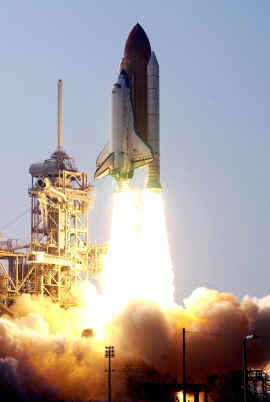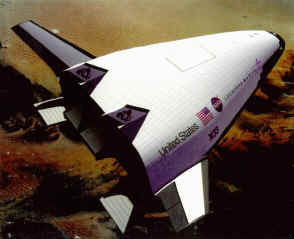SKY RAMP TECHNOLOGY
NASA hoped to build the X-33
RLV as a sub-orbitable prototype for the world’s first Single-Stage To Orbit (SSTO)
spacecraft - the Lockheed-Martin Venturestar. This would allow
safer and inexpensive space launches, compared to the “Space Shuttle,” which
requires two expensive first-stage semi-reusable booster rockets and a massive
disposable fuel tank. After many
years of research incorporating the latest technologies, NASA was unable
to develop a design that would allow the larger Venturestar to reach orbit under its own
power. As a result, the X-33 project was canceled in January of 2001.
We'll use it as an example, since it's the only modern fully-designed RLV with
known parameters, to prove that a SSTO RLV is possible with a rocket sled assist
to Mach 2 up a 2.5 mile track inclined 45 degrees, while remaining under 6 Gs. 
RLV SSTO is a dream that has eluded both NASA and the Russian space program for at least 40 years. Once the RLV concept is realized, there will be nothing thrown away and so the launch costs could eventually come down to merely the cost of the fuel. RLV assisted launch will be the most important development in space since the introduction of rockets themselves. The large scale development of the moon and Mars will be possible and millions of ordinary citizens can visit space. This event will be equivalent to the construction of the railroads from coast to coast in its effect on our economy and civilization.
But obstacles have arisen in the development of RLV launch. For example SSTO without assisted launch has a problem with deadweight scaling which prevent it from making orbit. Another problem for RLVs is they need a small surface to volume ratio. They are flying gas tanks which are not aerodynamic at launch. This makes towing and horizontal assisted launch impossible. Another problem is that mo/m for RLVs must be greater than .91, which is large, so the RLV must be on the order of the size of the X-33 or larger, making airplane drop launch difficult except for a extremely large rocket propelled hypersonic aircraft that has not been developed.
Let m0 be the total initial fully loaded mass of the rocket, ‘m’ the mass after the fuel is expended, V=exhaust velocity =4500 m/s, (calculated from H2+O Isp) v=8km/sec orbital velocity, t =8min time to orbit without having the initial velocity v0. “R” the usual value of m0/m for the case v0 =0. The t(vo) term is the decrease in time (term) to orbit due to the fact of having an initial velocity. So this time is subtracted from the real time to get an effective time.
t(v0 )=60X1.5sec (saves ~1.5 minutes in flight , maxQ from 50-85sec), V=4500(m/s)=isp for H2+O. t=8min., v0=700 m/s=Mach2 with pneumatic (or catapult) nondetonation heating. Thus in the rocket equation (resulting from integration of the impulse equation):
v=vo-gt+Vln(mo/m)so dividing by Vand
taking the exponential and solving for mo/m:
exp[(v-vo+gt-gt(vo))/V]=exp[(-vo-gt(vo))/V]exp[(v+gt)/V]=exp[(-vo-gt(vo))/V]R=mo/m
=1.42R again with R being the exponential term without assisted launch.
Thus, an assisted launch allows the booster to be .7 times smaller for unmanned payloads, nearly half the size! This allows even the Venturestar to make orbit! The X-33 design can only reach Mach 15, but an assisted inclined rocket sled launch can close the gap (to mach 24). Even with added mass in the form of reentry tiles (with a modification to X-33 like lifting body shape) it would clearly still have orbital possibilities.
Most assisted launch analysis fails to consider the pre maxQ vertical component of gt(vo) term in the impulse equation. This represents the required work against gravity had the larger fuel load been carried up. This term is 2-3 times larger than the vo itself. It represents essentially a large “amplification” of the effect of assisted launch. Nowhere in the most recent assisted launch reports is any analysis done of the impulse equation, let alone this central concept (saving time working against gravity with an otherwise large payload) to assisted launch.
The rocket sled at China Lake gives
Mach 4 for 130,000 lbs
payloads and so has already proven the viability of rocket sled assisted launch
on the scale required. This is viable today
for a large SSTO RLV with substantial payload. For an example of a rocket sled inclined rail assisted launch, we will
use four 656,000lb thrust Boeing RS-68 rocket engines (two on each side of a
sled) to launch an X-33 size RLV with sufficient speed to make orbit.
Parameters for an example
of an X-33 assisted launch
Launch weight of an X-33 = 273,000 lbs
Thrust of Boeing's RS-68 rocket engine = 656,000 lbs each
Newton's 2nd Law used to calculate required thrust F=ma
Sum of Forces =Air Resistance+Thrust+gravity+Friction=ma
4X656,000 lbs=2,624,000 lbs
Air Resistance
rV=m , V=Ax so dm/dt=rdV/dt=rA(dx/dt)=rAv in
D»(½)CrAv2
Given typical vehicle drag coefficient for streamlined vehicle D=.5, r»1kg/m3 at v»2X340m/sec then
Friction contributes little here.
Gravity Force
Take the sled plus rocket motors to be about 100,000 lbs weight at top of track since all the fuel has been used in the rocket motors. So
Fg =mgsinq =(273,000+100,000)sin45°=263,711 lbs
Total Force required for
6 gs; the maximum force for manned launches
Total Force=air resistance+Thrust+gravity+Friction=ma=m6*9.8
Total Force=D+Thrust+Fg=m6*9.8
Thrust-778,000-263,711=ma=(263,000/32)6*32=1,578,000= lbs
So the required Thrust = 2,620,000 lbs in comparison to 2,624,000 lbs thrust for four RS-68 engines. Note this represents the maximum thrust needed. This is because at the bottom the drag force is near zero even though there is on the order of 600,000 lbs fuel in the four shortened RS-68s there, so that the added gravity force is 600,000sin45»424,000 lbs, still far less than the drag force at the top given that this fuel has been expended by the time the sled reaches the top. So the thrust is sufficient here. The final question is how much track is needed?
Track Length for 6g acceleration and Mach 2 final velocity
v = sq root of 2as so s = v2/2a = (2*340)2/2*(6*9.8) = 3932m ~ 4km ~ 2.5miles
So the inclined track must be on
the order of 2.5 miles (13,200 feet) long. Since the Earth has hundreds of mountains over
8000 feet tall, building
rail track up a mountain at a 45-degree slope is certainly feasible; using the
same construction techniques used to build interstate highways and rail lines
through large mountain ranges. Passengers would be subjected to an
uncomfortable yet tolerable 6 gs for ten seconds up the ramp, then the rate of acceleration
and g force slows to 3 gs as the RLV ascends into Space under its own power.
In summary, a large SSTO RLV can be launched off a 2.5 mile inclined track at speeds of Mach 2+ using existing rocket technology. No research is required, just build the system. Take the China Lake track design, make it twice as large, and build it up the side of a large, steep mountain. This is the simple solution which billions of dollars in research funding has yet to recognize.